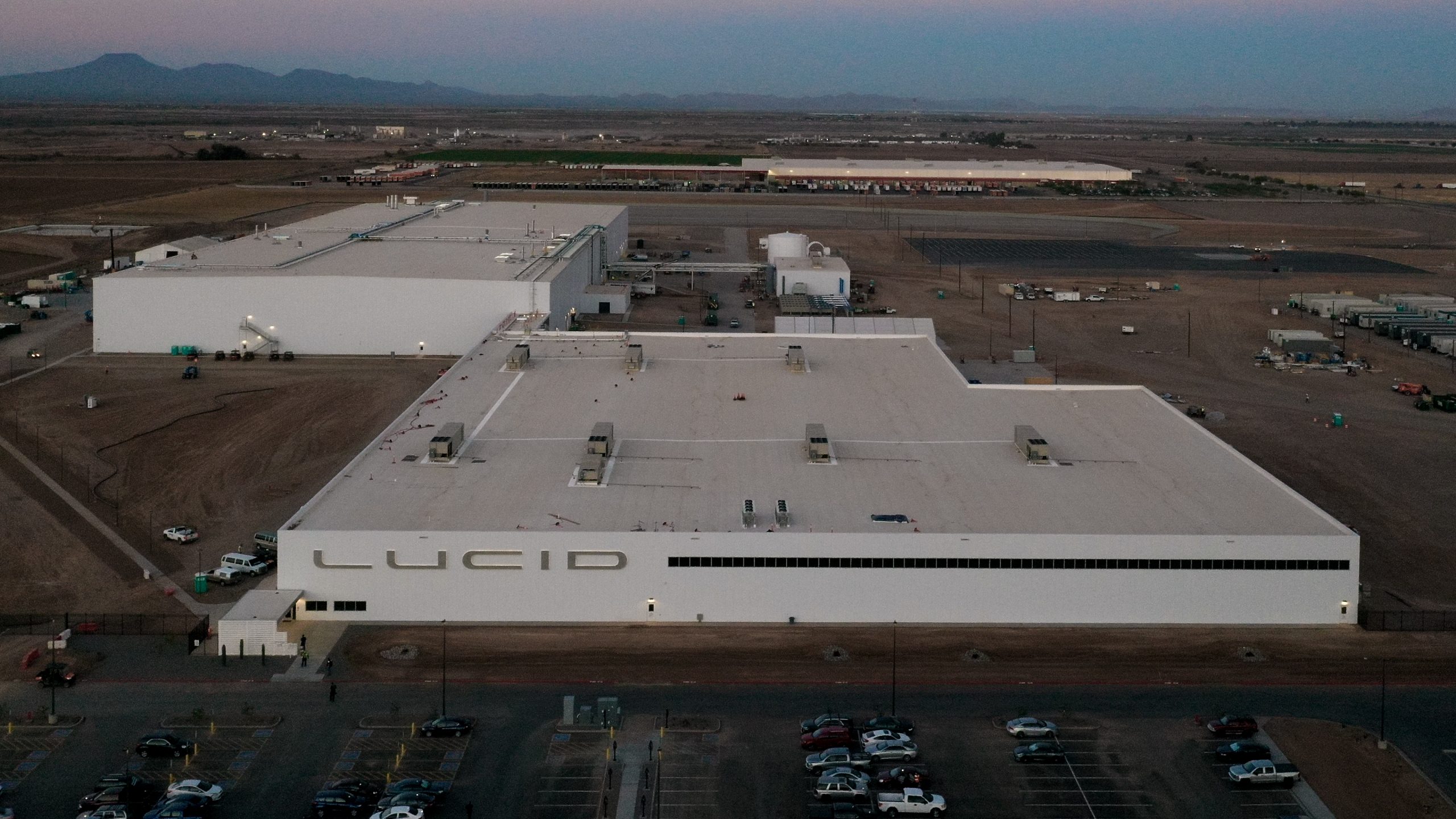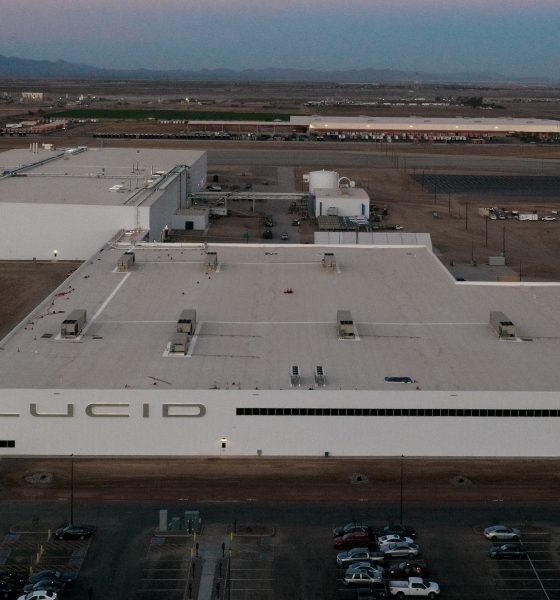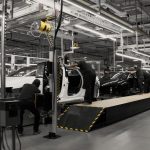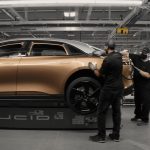Lucid Motors has officially announced the completion of its first phase of construction at its Advanced Manufacturing Plant (AMP-1) facility in Casa Grande, Arizona, and plans to begin the first production phase in Spring 2021. As the commissioning of production equipment and processes underway, Lucid looks to begin manufacturing its Dream Edition of the Air within the coming months, bringing another all-electric automaker to the highly competitive American car market.
The AMP-1 facility was designed with a future-ready focus that allows for additional phases of expansion at the site, which could come in handy if Lucid manages to sell a lot of vehicles. Lucid also stated that this is not the only phase of construction, and this marks the completion of the first phase only. The next phase is set to begin in early 2021 and will make way for the production of Lucid’s introductory SUV in 2023, which has been given the name Project Gravity.
Credit: Lucid Motors
Lucid CEO and CTO Peter Rawlinson detailed his company’s development of the massive land slot in Arizona in a press release from the automaker.
“We broke ground on the 590-acre Lucid AMP-1 site in Casa Grande, Arizona, on December 2, 2019, and slightly less than a year later we have completed the first purpose-built EV factory in North America. The effort and agility demonstrated by this team is truly astounding, as we’re already commissioning equipment compatible with the Lucid manufacturing system to start production of the next-generation EV, Lucid Air, in just a few months,” Rawlinson stated.
To ensure the production is accurate and effective and officially bring the plant into commission, Lucid has already built a full beta prototype test fleet, which comprises several Air models. Lucid’s manufacturing system utilizes advanced processes, including an aircraft-inspired riveted and bonded monocoque body structure, which replaces spot welds, a commonly used tactic in automotive manufacturing. The strategy behind using rivets and monocoque body structures was to increase the Air’s structural efficiency, a main focus of its introductory sedan.
When the production lines begin operation next Spring, Lucid says it will be capable of building 30,000 units annually, which will supply global markets beginning in North America. The Dream Edition will be first, with the Grand Touring and Touring models following shortly thereafter. The company’s base model, which was recently labeled the Lucid Air Pure, will begin production in early 2022.
Lucid chose Arizona for its first production plant for several reasons. Not only were infrastructure, talent, location, and pre-existing automotive supply chain significant advantages, but the land was suitable for a large facility that would invite expansions as the company intends to grow over the coming years. The company purposely chose this site, intending to build onto the plant within the next few years, and it’s state-of-the-art, water-based paint shop can be included as it meets the needs of all future phases of the factory, Lucid said. Four phases of construction are planned through 2029, taking the current square footage of 999,000 to 5.1 million by when it is completed.
- Lucid’s Water-Based paint facility. (Credit: Lucid Motors)
- Lucid’s Water-Based paint facility. (Credit: Lucid Motors)
In 2028, Lucid will be able to build 400,000 vehicles per year at the facility.
“In building this factory, we adhered to several important manufacturing philosophies, including the tenets of ‘Future Ready’ and ‘On Time,’ together which have allowed us to effectively manage our investment and build a brand new factory from the ground up,” Vice President of Manufacturing Peter Hochholding said. “As we add new platforms and vehicles to our lineup, the planning that went into this facility ensures that we will always be able to keep up with growing customer demand for advanced electric vehicles.”

News
Tesla FSD fleet is nearing 7 billion total miles, including 2.5 billion city miles
As can be seen on Tesla’s official FSD webpage, vehicles equipped with the system have now navigated over 6.99 billion miles.

Tesla’s Full Self-Driving (Supervised) fleet is closing in on almost 7 billion total miles driven, as per data posted by the company on its official FSD webpage.
These figures hint at the massive scale of data fueling Tesla’s rapid FSD improvements, which have been quite notable as of late.
FSD mileage milestones
As can be seen on Tesla’s official FSD webpage, vehicles equipped with the system have now navigated over 6.99 billion miles. Tesla owner and avid FSD tester Whole Mars Catalog also shared a screenshot indicating that from the nearly 7 billion miles traveled by the FSD fleet, more than 2.5 billion miles were driven inside cities.
City miles are particularly valuable for complex urban scenarios like unprotected turns, pedestrian interactions, and traffic lights. This is also the difference-maker for FSD, as only complex solutions, such as Waymo’s self-driving taxis, operate similarly on inner-city streets. And even then, incidents such as the San Francisco blackouts have proven challenging for sensor-rich vehicles like Waymos.
Tesla’s data edge
Tesla has a number of advantages in the autonomous vehicle sector, one of which is the size of its fleet and the number of vehicles training FSD on real-world roads. Tesla’s nearly 7 billion FSD miles then allow the company to roll out updates that make its vehicles behave like they are being driven by experienced drivers, even if they are operating on their own.
So notable are Tesla’s improvements to FSD that NVIDIA Director of Robotics Jim Fan, after experiencing FSD v14, noted that the system is the first AI that passes what he described as a “Physical Turing Test.”
“Despite knowing exactly how robot learning works, I still find it magical watching the steering wheel turn by itself. First it feels surreal, next it becomes routine. Then, like the smartphone, taking it away actively hurts. This is how humanity gets rewired and glued to god-like technologies,” Fan wrote in a post on X.
News
Tesla starts showing how FSD will change lives in Europe
Local officials tested the system on narrow country roads and were impressed by FSD’s smooth, human-like driving, with some calling the service a game-changer for everyday life in areas that are far from urban centers.

Tesla has launched Europe’s first public shuttle service using Full Self-Driving (Supervised) in the rural Eifelkreis Bitburg-Prüm region of Germany, demonstrating how the technology can restore independence and mobility for people who struggle with limited transport options.
Local officials tested the system on narrow country roads and were impressed by FSD’s smooth, human-like driving, with some calling the service a game-changer for everyday life in areas that are far from urban centers.
Officials see real impact on rural residents
Arzfeld Mayor Johannes Kuhl and District Administrator Andreas Kruppert personally tested the Tesla shuttle service. This allowed them to see just how well FSD navigated winding lanes and rural roads confidently. Kruppert said, “Autonomous driving sounds like science fiction to many, but we simply see here that it works totally well in rural regions too.” Kuhl, for his part, also noted that FSD “feels like a very experienced driver.”
The pilot complements the area’s “Citizen Bus” program, which provides on-demand rides for elderly residents who can no longer drive themselves. Tesla Europe shared a video of a demonstration of the service, highlighting how FSD gives people their freedom back, even in places where public transport is not as prevalent.
What the Ministry for Economic Affairs and Transport says
Rhineland-Palatinate’s Minister Daniela Schmitt supported the project, praising the collaboration that made this “first of its kind in Europe” possible. As per the ministry, the rural rollout for the service shows FSD’s potential beyond major cities, and it delivers tangible benefits like grocery runs, doctor visits, and social connections for isolated residents.
“Reliable and flexible mobility is especially vital in rural areas. With the launch of a shuttle service using self-driving vehicles (FSD supervised) by Tesla in the Eifelkreis Bitburg-Prüm, an innovative pilot project is now getting underway that complements local community bus services. It is the first project of its kind in Europe.
“The result is a real gain for rural mobility: greater accessibility, more flexibility and tangible benefits for everyday life. A strong signal for innovation, cooperation and future-oriented mobility beyond urban centers,” the ministry wrote in a LinkedIn post.
News
Tesla China quietly posts Robotaxi-related job listing
Tesla China is currently seeking a Low Voltage Electrical Engineer to work on circuit board design for the company’s autonomous vehicles.

Tesla has posted a new job listing in Shanghai explicitly tied to its Robotaxi program, fueling speculation that the company is preparing to launch its dedicated autonomous ride-hailing service in China.
As noted in the listing, Tesla China is currently seeking a Low Voltage Electrical Engineer to work on circuit board design for the company’s autonomous vehicles.
Robotaxi-specific role
The listing, which was shared on social media platform X by industry watcher @tslaming, suggested that Tesla China is looking to fill the role urgently. The job listing itself specifically mentions that the person hired for the role will be working on the Low Voltage Hardware team, which would design the circuit boards that would serve as the nervous system of the Robotaxi.
Key tasks for the role, as indicated in the job listing, include collaboration with PCB layout, firmware, mechanical, program management, and validation teams, among other responsibilities. The role is based in Shanghai.
China Robotaxi launch
China represents a massive potential market for robotaxis, with its dense urban centers and supportive policies in select cities. Tesla has limited permission to roll out FSD in the country, though despite this, its vehicles have been hailed as among the best in the market when it comes to autonomous features. So far, at least, it appears that China supports Tesla’s FSD and Robotaxi rollout.
This was hinted at in November, when Tesla brought the Cybercab to the 8th China International Import Expo (CIIE) in Shanghai, marking the first time that the autonomous two-seater was brought to the Asia-Pacific region. The vehicle, despite not having a release date in China, received a significant amount of interest among the event’s attendees.











